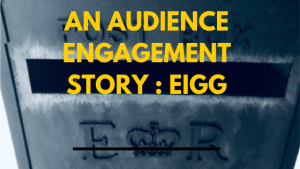What does a “rural audience” actually look like? Can it even be defined? Following our first residency BRAW designer, Lisa Baxter, gives us an anecdotal portrayal of what this might be.
Written by – Lisa Baxter, The Experience Business in Jan 2018
We kicked-off the programme with 3 days of dialogue and exchange to deepen mutual understanding and engender a sense of shared purpose amongst the group. First off – the audience.
Our promoters represent three different rural communities – Lucy Conway (Isle of Eigg), Kresanna Aigner (Forres), Joni Brown and Ian Prescott (Lochgoilhead). As each talked about their place and their community, areas of commonality emerged.
The population
There are people who are birthed and earthed, rooted to place; either never leaving (‘born and bred’) or eventually returning (‘prodigals’). There are ‘incomers’ who choose to make a life there, drawn to whatever it is about the place or community that attracts them (‘lifestylers’). Artists, makers, musicians and creatives seem particularly drawn, perhaps to the natural beauty and landscape, the remoteness and concomitant mindset, described by one promoter as the edge effect – “the edge of the farmer’s field where there is the most fertility”.
The people
People are known, faces are familiar and different-ness stands out. There are public people and hidden people, those who are engaged in the community and the outliers, those who are open and those who are closed-minded, inward and outward looking, resistant to and welcoming of change. People pull together for the common good. Conversely, coteries and factions exist. Invisible lines demarcate and separate groups. Tensions bubble under the surface, especially for the uninitiated. All this, of course, is no different to any other population, save perhaps for the influence of population size because the smaller the community, the more pronounced everything becomes.
The mindset
Our promoters painted a picture of rural life operating within the limitations of location, landscape, distance and the elements – slowing the pace and increasing the struggle. The practicalities of life are felt more acutely. People are more resilient and patient by necessity. Co-operation is important in an environment where scarcity bites, choice is limited, and things take longer to do. People have each other’s back.
The community
Whilst the pace of life might be slower and the experience harder, life for these rural communities can be incredibly busy and full, with strong social bonding and plenty of community events. The desire to enjoy a shared social experience and a sense of belonging may well be defining.
The performance context
Context is significant here as these gatherings usually take place in social and civic spaces where communities gather for a variety of reasons; to meet, talk, debate, sing, dance, play music. Ownership of these buildings may be more keenly felt than a theatre, the roles they play in people’s lives more directly relevant and valued. For a touring company, this offers a distinctive performance context – more socially vibrant and less formal. The questions that emerge here are:
- To what degree might a socially vibrant performance context challenge artistic requirements around silence, focus and regard?
- Does high value placement on social capital diminish the ‘status’ of the artist as the main event? And does this matter?
- Might artists need to rethink their invitation to, and intended contract, with the audience?
The audience
When it comes to the impulse to experience a specific piece of work, urban and rural audiences will share the same considerations around, for example, art form, theme, personal or topical relevance, the story, degree of appetite for the familiar, the new, the provocative. However, within the context of smaller communities, the impact of failure (however that is interpreted) may have greater consequences in relation to attendance, intrinsic experience, trust in programme choice, advocacy and propensity to return. Audience considerations therefore have an important role to play as part of the BRAW Programme. The questions that emerge here are:
- How does being both an inward and outward looking community impact on the desire to see its world reflected back at it and/or to experience something completely new and different?
- To what degree might hybridity, experimentation and unusual performance contexts attract or deter people that are variously resistant to and welcoming of, change?
- How pronounced is the appetite to engage with alternative or challenging themes and concepts when a community is both open and closed minded?
Whilst these questions are not the unique to rural touring, and have no definitive answers, they provide a useful starting point for our artists as they embark on making artistically vibrant work specifically for rural audiences.
Photo taken by Lisa Baxter at Cove Park
Read more from BRAW below





















